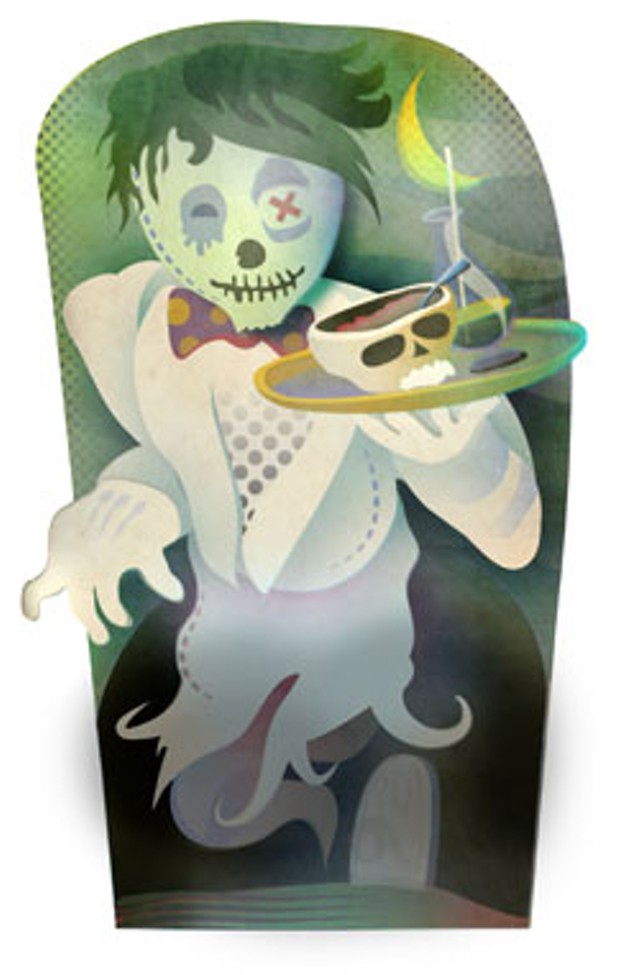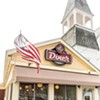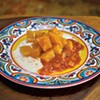Published October 31, 2012 at 6:53 a.m.
The food that we love stays with us, and not just in our love handles. The recipe that grandma never got around to writing down can haunt us when she’s gone. So can our memories of lost restaurants.
Even restaurants where we never got a chance to eat can become objects of nostalgic fascination. The recent demolition of Shelburne’s Harbor Hide-A-Way may have saddened locals who remember the restaurant in its mid-century heyday, but here at the Seven Days food desk, a vintage menu just now made us hungry — and curious. What was exotic about the Hide-A-Way’s Chicken With Exotic Sauce? We never did find out, but this and similar questions sent us on a tour of Vermont’s restaurant graveyard.
Combing through the relics and consulting the fans of beloved late local eateries, we unearthed recipes that taste as fresh as they did long before diners started using terms like “locavore” and “terroir.” We decided to pass them on to posterity — and hope you enjoy tasting the shades of restaurants past as much as we did.
— A.L.
Zack’s on the Rocks, Montgomery Center
Part of the romance of this ski-town restaurant was its remoteness: Diners had to head up Hazen’s Notch to the cottages at the top, one of which housed the eatery. But much of Zack’s mystique swirled around Zack himself — aka owner and chef Jon Payne Zachadnyk, who ran the restaurant for 30 years until it closed in 2002. Zachadnyk, who passed away in 2011, started out as an army cook, but no one would have guessed that from his wardrobe of purple caftans, capes and crowns.
The restaurant had a color scheme to match his outfits — including purple sugar at every table. That was specially made by a confectioner in Richmond, says Rob Barnard, a former Zack’s cook and now owner of Snow Shoe Lodge & Pub in Montgomery Center, or, as Zachadnyk called it, “Monkey Center.” Barnard still offers Zachadnyk’s dishes as specials at his eatery.
Our other informant was Brenda Cardinal, who used to bake the breads in Zack’s bread basket — including French, pecan and chocolate — fresh every day. With them came chocolate butter, made from a recipe that Zachadnyk never shared with anyone, though both Cardinal and Barnard guess it was butter whipped with chocolate syrup.
Because Zachadnyk refused to write down recipes, controversy surrounds the preparation of one of his signature dishes, Chicken Banana. Cardinal recommends cooking the chicken already stuffed with the banana, while Barnard says to cook the elements separately, then assemble them. We chose the latter method for the version below, but either way, the result is disarmingly delicious and far less sweet than one might expect.
Before the main course, enjoy a creamy appetizer of Mushrooms Monkey Center. And wear purple.
Chicken Banana (serves two)
- Butter
- 4 small chicken breasts
- Seasoned bread crumbs
- 1 large banana
- ¼ cup slivered almonds
- Banana liqueur
- Heat oven to 400 degrees. Melt butter in a heavy skillet and coat chicken breasts with seasoned bread crumbs.
- Peel and halve banana. Brown chicken and banana lightly on both sides, then put pan in oven for 15 to 20 minutes until chicken is fully cooked. While chicken is cooking, brown almond slivers in butter, leaving just enough liquid for a bit of brown-butter sauce.
- When chicken is finished, place one breast on plate and cover with banana half. Top that with a second chicken breast and dress with brown butter and almonds. Lightly drizzle with banana liqueur and serve with hash browns and the “vegetable of the day.” Zack’s favorites included green beans with aniseeds and squash with butter and powdered brown sugar.
Mushrooms Monkey Center (serves four)
- 2 tablespoons butter
- 2 tablespoons flour
- ½ cup white wine
- 1 cup heavy cream
- 16 ounces white mushrooms
- Chopped fresh tarragon to taste
Heat a skillet to medium, melt butter and add flour to make a roux. Stir for one to two minutes. Add wine and cook until aromatic and slightly reduced. Throw in cream, stir to combine and reduce heat to medium low. Add mushrooms and cook until they are softened and sauce is thick. Stir in chopped tarragon. Serve over garlic bread.
— A.L.
*****
The Shed Restaurant & Brewery, Stowe
Since the Shed in Stowe closed a year ago, locals have been missing both the beer and the rustic, warm vibe. Also mourned is the iconic Shed burger — a moist, drippy creation that hadn’t changed much since the 1960s, when it was the only item on the menu.
Though the Shed is gone, malty Shed Mountain Ale is still brewed by Middlebury’s Otter Creek Brewing, which recently began offering it in bottles. This is a boon for Shed-burger lovers everywhere. The burger’s recipe is now owned by Otter Creek, according to Shed cofounder Kenneth Strong, but it’s no great secret that its flavor came from giving the meat a long soak in Shed Mountain Ale.
Strong says there are other spices in the blend, but simply marinating ground beef in Shed Mountain ale, then dosing it with salt and pepper before grilling, yields a peppery, zesty burger.
The other key components of a finished Shed burger are Cabot cheddar melted across the top and a Thomas’ English Muffin instead of a bun. According to Strong, it was the president of S.B. Thomas baking company himself, Bob Swanson, who first suggested Strong serve his burger on the nook-and-crannied muffins. Swanson, who lived in Stowe in the mid-1960s, brought in a case for the kitchen to try and before long, English muffins were an essential component of the Shed burger.
“I like to think we were responsible for the rise of Thomas’ English Muffins,” Strong jokes. Restless in his retirement, the restaurateur still entertains the idea of opening another Shed elsewhere in Stowe. Is the Shed burger ripe for resurrection?
Shed Burger (makes four small burgers, or three of the classic [larger] Shed size)
- 1 pound ground beef (I used Hardwick Beef, which is grass fed)
- ½ cup Shed Mountain Ale (about one third of a bottle)
- ½ teaspoon salt ½ teaspoon pepper
- 4 slices Cabot cheddar cheese
- 3 or 4 Thomas’ English Muffins
- Lettuce, tomato, onion and condiments to taste
- In a large bowl, combine the beef with the ale. Knead with your hands until well combined, then cover and chill for at least two hours, preferably more.
- Remove the beef from the refrigerator about five minutes before you’re ready to cook. Either heat a grill or put a pan on medium heat. Form the burgers into patties of 3/4-inch thickness (I got four burgers out of a pound, but the classic Shed burger was a heaping 1/3 pound); then coat both sides generously with salt and pepper. Cook patties roughly two to three minutes per side for medium-rare doneness, placing a slice of Cabot cheddar on each burger while cooking the second side.
- In the meantime, lightly toast English muffins in a toaster oven or on the grill. Slather with your favorite condiments and accoutrements and serve.
— C.H.
*****
Déjà Vu Café, Burlington
Nowadays, we complain when it takes six months for an anticipated restaurant to open. When Déjà Vu Café served its first meal on Pearl Street in 1978, the opening followed four years of work on the site, which would later be home to Parima and now houses Three Needs.
Original owner Brian Fox took his time because of an unflagging attention to detail, recalls Peter Straube, Déjà Vu Café’s one-time general manager. Fox “was the most perfectionist person I’ve ever met,” says Straube, who’s now program director of Champlain College’s hospitality programs.
That fussy streak produced a building with a renowned art-deco atmosphere; inside may have been Burlington’s first great bistro. Among Déjà Vu’s Gallic staples were Breton-style buckwheat crêpes such as the Crêpe Déjà Vu, filled with “smoky sausage, fresh apples and Muenster cheese” and served with maple syrup. Sound familiar? The combination lives on as the Déjà Vu Crêpe at the Skinny Pancake.
In Déjà Vu’s later days, it was owned by Robert Fuller, now co-owner of Leunig’s Bistro, where he keeps up the tradition of the long-gone restaurant’s classic French offerings, such as soupe au pistou. Déjà Vu’s creamy Potage Neufchâtel isn’t available at Leunig’s, however, or anywhere else in the area. Straube was happy to share chef Michael Moser’s vintage recipe.
Potage Neufchâtel
- 5 tablespoons butter
- 1 pound spinach
- 4 large white leeks
- 6 tablespoons flour
- 4 ½ cups chicken stock
- 4 ½ cups water
- 1 teaspoon salt
- 2 eight-ounce packages of cream cheese
- Salt and pepper to taste
- 2 cups yogurt
- 4 egg yolks
- 2 cups cubed cooked ham
- 1 cup chopped chives
- Heat 2 1/2 tablespoons of butter in a soup kettle. Chop spinach and leeks and cook gently in butter. When soft, sprinkle with flour and cook for two minutes over medium heat, stirring constantly. Remove from fire and add chicken stock, water and salt. Return kettle to low heat, stirring until slightly thickened. Simmer 15 minutes.
- Mash cream cheese in a small bowl. Sprinkle with salt and pepper, then stir in yogurt and egg yolks. Beat until smooth.
- Sauté ham in remaining butter. Carefully temper cream cheese mixture with hot soup by mixing a tablespoon of soup into the mixture outside the pot; then stir into the pot. Cook over low heat for five minutes, add ham, top with chives and serve.
— A.L.
*****
Carbur’s Restaurant, Burlington
October 2002 was the end of an era when Carbur’s closed at 150 St. Paul Street. The brainchild of brothers Carl and Burr Vail opened in 1974 on the site now home to American Flatbread. Carbur’s was built around fun, with quirky, antique furniture, a chandelier made of brass musical instruments and a menu that at times stretched for 16 pages.
Straube, later of Déjà Vu Café, originally came to Vermont in 1983 to work at Carbur’s. Of the cuisine at Carbur’s, which was also known for its expansive beer list, Straube remembers, “This was a time when things like taco salads were new, and we were doing crazy things like frying burritos.”
Anyone who dined in Burlington during the Carbur’s years has a favorite sandwich, whether it was the Mae West — billed as “the only sandwich boycotted by NOW” and featuring “roasted turkey bosom, melted Swiss cheese, with mushrooms and tarragon mayo (served hot)” — or a chicken chimichanga, “alias, Mexican eggroll.” But no one could argue that Carbur’s biggest thing between sliced bread was the Queen City Special, trumpeted as Vermont’s only five-decker sandwich.
Queen City Special (serves as many as it takes to eat it)
- 6 slices hearty sandwich bread
- Sliced tomatoes Lettuce leaves
- Dressing of your choice
- Roast beef
- Turkey bosom
- Sliced, baked ham
- Seafood salad
- Shrimp salad
Get to stacking! Begin with one piece of bread, spread it with dressing, cover it with tomatoes and lettuce leaves, then pile it with roast beef. Repeat the process until you cap the shrimp salad with the final slice of bread.
But with Carbur’s now long gone, exercise caution. You will not be provided with the “free medical attention” promised in one 1983 menu for anyone suffering ill effects from consuming this $6.95 wonder.
— A.L.
*****
Scrumptious, Burlington
Long before my time in Burlington, a café named Scrumptious operated in the North Champlain Street spot where Nunyuns Bakery & Café currently resides. Scrumptious’ renown endures, and its tomato-basil soup remains on regular rotation in the kitchen of Seven Days designer Diane Sullivan, who says she could “dive into a vat of it” and provided us with a recipe.
I’ve never been a fan of tomato soup of any stripe, but this version changed my mind. Perhaps it’s the generous doses of heavy cream and butter that make this simple soup silky and addictive. The only addition I made to Scrumptious’ recipe is salt to kick up the flavor; next time, I may try some crushed red pepper, too.
Tomato-Basil Soup (serves four)
- 2 cans whole, peeled tomatoes (I used San Marzano)
- 3 cups tomato juice
- 2 tablespoons basil, slivered, plus additional for garnish
- ½ teaspoon sea salt (or to taste)
- ¼ teaspoon pepper (or to taste)
- 1 cup heavy cream
- ¼ pound butter (one stick)
Process the tomatoes in a blender or food processor until smooth. Transfer to a soup pot and add the tomato juice, basil, salt and pepper. Simmer for 30 minutes, stirring occasionally. Add heavy cream and butter and stir over low heat until heated through. Garnish with basil leaves.
— C.H.
*****
Dog Team Tavern, New Haven
The chalkboard menus changed daily, but little else ever did. When diners entered the historic house known as the Dog Team Tavern, they chose from prime rib, country-fried chicken and other resolutely old-fashioned dishes before taking their seats.
After they settled themselves at the table, a server carted in the relish wheel, a wooden contraption that looked like a ship’s steering wheel, with miniature buckets of side dishes hanging from pegs on its spokes. The wide variety included corn relish; Texas Caviar, or garlicky beans in a cider vinaigrette; apple butter; horseradish cottage cheese; and super-sweet roasted beets.
In 2006, the Dog Team Tavern came to a tragic end when final owner Christopher Hesslink set the building ablaze and took his own life there. Diners will never again enjoy dinner at the restaurant that was listed on the National Register of Historic Places, or peruse its display of antiques. But, thanks to a recipe published in Sue Schildge’s 1995 book Vermont: A Culinary Journey, they can taste its sticky buns, the gooey “appetizer” that made the Dog Team Tavern a landmark.
Sticky Buns (serves 10 to 15)
- ½ cup sugar
- 1 ½ teaspoons salt
- ½ cup butter
- 1 cup hot sieved or mashed potatoes (reserve 1 ½ cups of the potato cooking water)
- 1 package yeast
- 2 eggs
- 7 cups flour
- 3 cups brown sugar
- Water
- Chopped walnuts
- ¼ cup melted butter
- 2 cups cinnamon-sugar mixture (¼ cup cinnamon to 1 ½ cup sugar)
- Add sugar, salt and butter to hot potatoes. When mixture is lukewarm, add yeast, eggs and potato water.
- Stir in flour to make a stiff dough. Knead until smooth. Put in greased bowl and let rise until double in bulk. Punch down and refrigerate. Do not use dough until thoroughly chilled; feel free to wait overnight or just a few hours. It will keep several days.
- When ready to use, butter three 8-inch pans. Cover bottom of pans with about 1/3-inch brown sugar. Add just enough water to moisten sugar. Sprinkle with chopped walnuts.
- Roll dough out about 1/3 of an inch thick and brush with melted butter. Sprinkle with cinnamon-sugar mixture. Roll dough up like a jelly roll and cut in 1/2-inch circles. Place these side by side in the pans of sugar. Let rise until double in bulk.
- Bake in 350 degree oven for 25 to 30 minutes. Invert pan on a plate while still hot to avoid sticking. Serve immediately.
— A.L.
*****
Resurrecting Dead Drinks
At its peak, Shelburne’s Harbor Hide-A-Way reportedly attracted passing celebrities such as Katharine Hepburn and Bob Dylan. But what did they drink? Though I have a 1957 Hide-A-Way menu, I couldn’t find a chef or bartender from that era to elucidate any of the restaurant’s “fanciful creations” — such as the Harbor Cocktail, a “cool and refreshing” concoction of “New England rum blended with maple syrup and lemon juice.”
I tried my hand at a Harbor Cocktail anyway, using Smugglers’ Notch Distillery Rum. Though it turned out admirably boozy and sweet-sour, I thought it needed a little something extra. If you have some on hand, a splash of the ginger liqueur Domaine de Canton adds a layer of spiciness that fuses the flavors into a delicious whole.
Harbor Cocktail (serves one)
- 3 ounces dark ru
- 1 ounce fresh-squeezed lemon juice (I used Meyer lemons)
- 1 teaspoon maple syrup
In a shaker filled with ice, combine rum, lemon juice and maple syrup. Add a splash of Domaine de Canton, if desired. Shake to combine, then strain into a tumbler filled with ice. Garnish with lemon and serve.
Gin & It
In the 1950s and 1960s, gin ruled as a base for cocktails, from gimlets to Tom Collinses. No doubt the once-common Gin & It made many an appearance on Burlington bars of yore. Basically a sweetish martini — though it’s not as treacly as it sounds — this amber-colored drink looks especially retro with an old-school maraschino cherry sunk at its bottom.
- 2 ounces gin
- 2 ounces sweet vermouth, such as Noilly Prat
- Dash of citrus bitters, such as Urban Moonshine
- Maraschino cherry
In a shaker or pint glass filled with ice, combine gin, vermouth and bitters. Stir, then strain into a martini glass. Garnish with a maraschino cherry and serve.
— C.H.
More By This Author
Speaking of Food, recipe
-

A Multilayered Career Leads a Seasoned Chef to Middlebury’s Swift House Inn
Mar 12, 2024 -

Swedish Cinnamon Rolls: A Recipe for 'Kanelbullar'
Mar 12, 2024 -

Q&A: Howard Fisher Delivers Meals on Wheels With a Side of Good Cheer
Dec 20, 2023 -

Video: Howard Fisher Delivers Meals on Wheels
Dec 14, 2023 -

Mealtime: Greek-Style Lamb Chops
Nov 14, 2023 - More »
Comments
Showing 1-1 of 1
Comments are closed.
From 2014-2020, Seven Days allowed readers to comment on all stories posted on our website. While we've appreciated the suggestions and insights, right now Seven Days is prioritizing our core mission — producing high-quality, responsible local journalism — over moderating online debates between readers.
To criticize, correct or praise our reporting, please send us a letter to the editor or send us a tip. We’ll check it out and report the results.
Online comments may return when we have better tech tools for managing them. Thanks for reading.















































